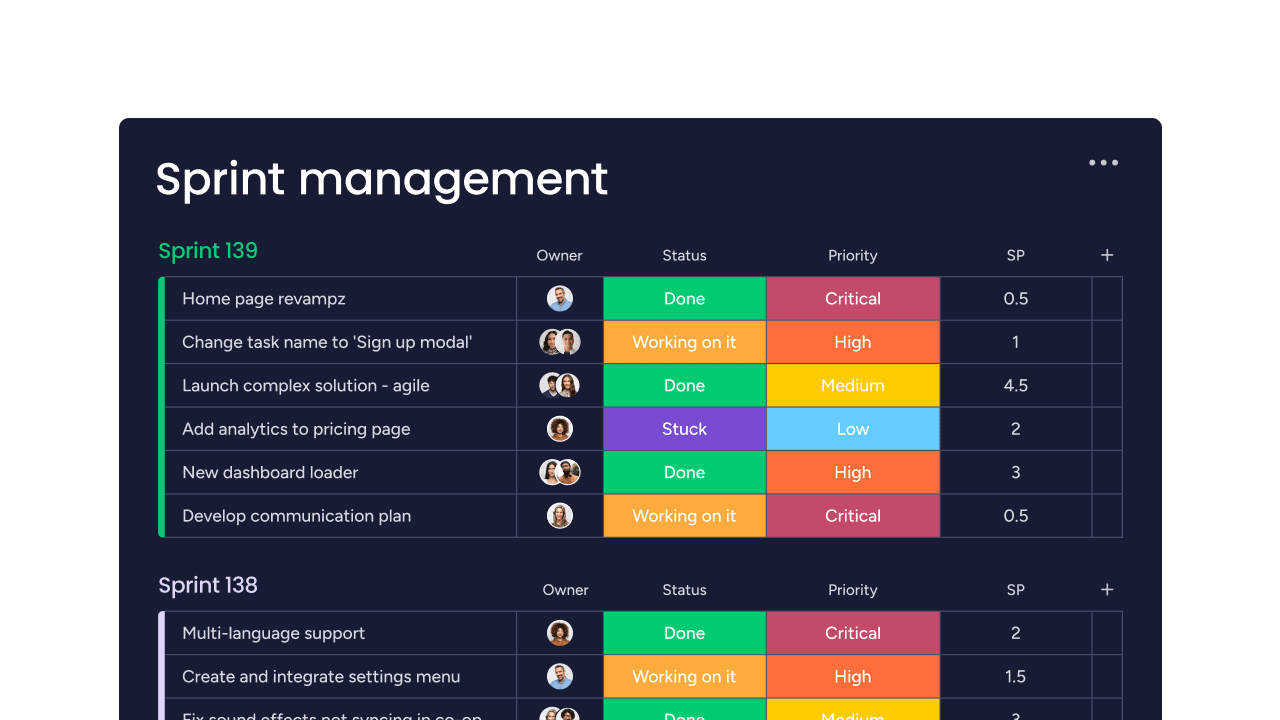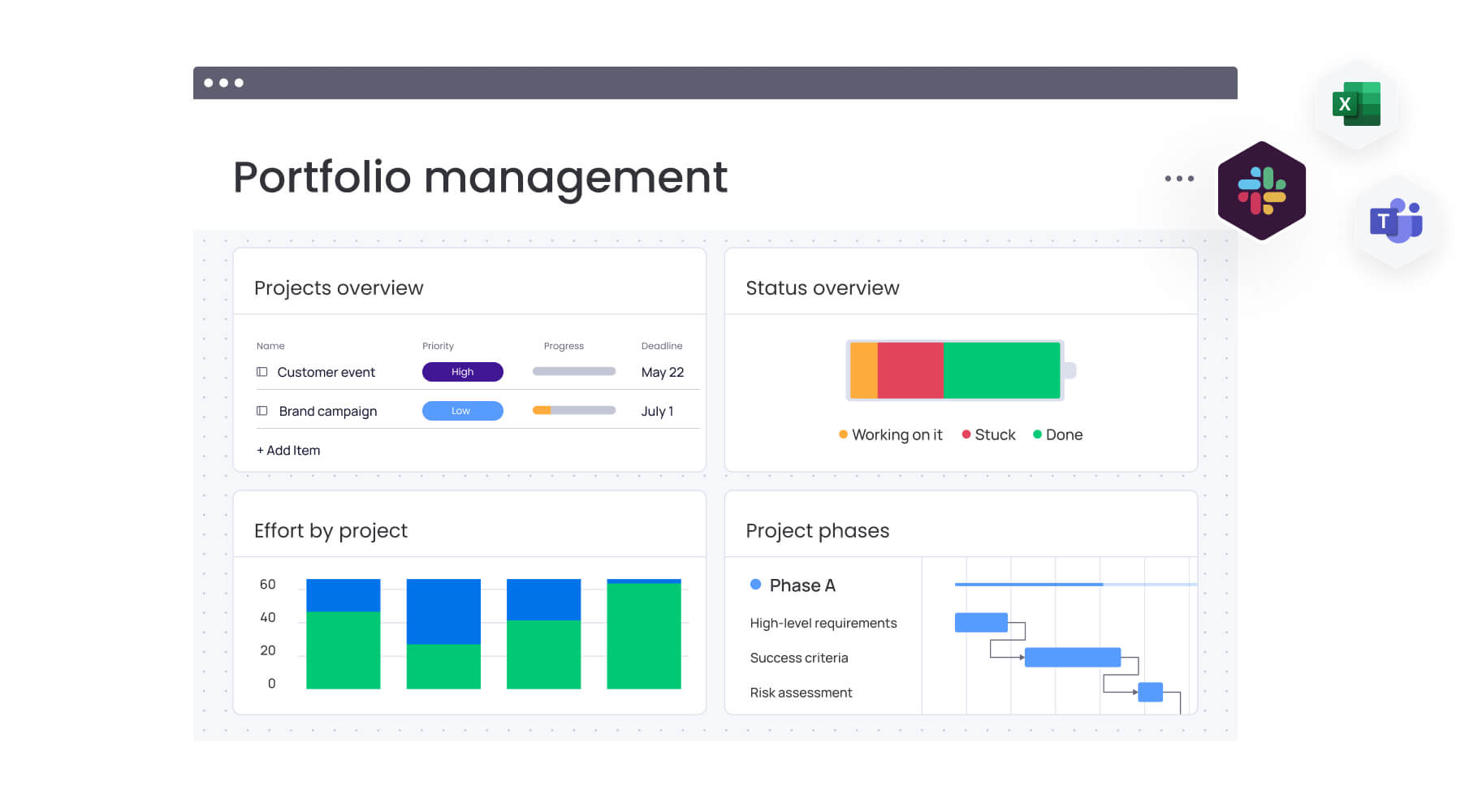For a single-product company, focus is the superpower. Every engineer, dollar, and day is aimed at one target. But as you grow and add new products to the mix, that clarity can fade. Suddenly, your best teams are stretched thin, and your budget is a battleground for competing priorities.
This transition to portfolio-level thinking is where many growing companies stumble. Product portfolio management provides the framework to navigate this complexity. It’s the practice of treating all your products as a single, strategic investment portfolio. Instead of letting individual products compete for resources, you make deliberate choices about where to invest, what to maintain, and which ideas to retire to drive overall business growth.
With this guide, you will explore how to balance your product mix, align teams, and build flexible processes that give you the strategic visibility and operational control required to ship faster and with greater confidence. It covers the core components of a strong portfolio strategy, from setting objectives to choosing the right analysis frameworks.
Key takeaways
- Balance your product mix strategically: combine stable revenue generators with growth products to protect against market changes while capturing new opportunities.
- Use data, not gut feelings, for portfolio decisions: track clear metrics like revenue distribution and growth rates, leveraging advanced analytics for informed investment choices.
- Achieve unified visibility across your entire portfolio: manage products from concept to retirement, ensuring all teams are aligned with real-time dashboards and integrated platforms.
- Review and adjust your portfolio regularly: conduct formal reviews quarterly and monitor key metrics continuously to adapt to market changes and enable dynamic resource optimization.
- Align all stakeholders around shared portfolio goals: break down silos between product, engineering, and leadership teams to ensure everyone works toward the same strategic objectives, facilitated by a single source of truth.

What is product portfolio management?
Product portfolio management is the practice of overseeing all your company’s products as one strategic unit. This means you’re making decisions about which products to develop, maintain, or retire based on how they work together to achieve your business goals — a practice that, according to research from Beyond the Backlog, can lead to 50% higher market capitalization over five years compared to the average.
This approach mirrors investment diversification: you avoid placing all capital in a single venture. Instead, you maintain a mix of products that serve different purposes: some generate steady revenue, others target new markets, and some explore future opportunities.
Understanding product portfolio fundamentals
Your product portfolio includes every product and service your company offers. These products are organized into product lines (groups of similar products) and categories (broader market segments).
The following elements define a portfolio structure:
- Product lines: related products that serve similar customer needs.
- Portfolio breadth: how many different product lines you offer.
- Portfolio depth: the variety within each product line.
- Product types: core products (steady revenue), growth products (emerging opportunities), and innovation products (future bets).
How does product portfolio management drive business growth?
Portfolio management helps you capture more market opportunities by maintaining the right mix of products. This allows you to diversify your offerings, ensuring that if one product struggles, others can carry the business forward.
This approach also ensures your resources go where they’ll have the most impact. Instead of spreading investments equally across all products, you can direct more funding toward high-potential opportunities while maintaining products that provide stable cash flow.
The evolution of portfolio management
Portfolio management has transformed with digital technology. Companies now use real-time data and AI to make portfolio decisions instead of relying on quarterly reviews and gut feelings.
Customer feedback loops and Agile development have also shortened decision cycles. With modern platforms like monday dev, you can now adjust your portfolio strategy in weeks rather than years, responding quickly to market changes with lean portfolio management.
Product portfolio management vs product management
Both roles are essential to building successful products, but they operate at different levels. Product management focuses on delivering one great product, while product portfolio management ensures that every product contributes to the company’s overall strategy.
The details below highlight how these two disciplines differ in focus, decision-making, and success metrics — and how they work together to drive business growth.
| Aspect | Product portfolio management | Product management |
|---|---|---|
| Focus | All products together | One product at a time |
| Decisions | Where to invest resources across products | Which features to build |
| Timeline | Long-term strategy (years) | Short-term execution (months) |
| Success metrics | Overall portfolio ROI | Individual product KPIs |
Key differences in scope and strategy
A product manager dives deep into one product. They talk to users, prioritize features, and work with developers to solve specific customer problems.
A portfolio manager takes the 30,000-foot view. They decide which products deserve more investment and which should be phased out based on overall business impact.
When each approach works best
Product management works best when you have one or two products that need intense focus. Startups and focused businesses thrive with this approach.
Portfolio management becomes essential once you have multiple products or serve different market segments. If you’re juggling various products competing for the same resources, you need portfolio-level coordination, as well as clarity on project management vs product management roles.
How both roles work together
In successful organizations, product managers and portfolio managers collaborate closely. Product managers provide on-the-ground insights about their products, often supported by product management software, while portfolio managers ensure everything aligns with company strategy.
Dedicated platforms bridge this gap by giving both roles shared visibility. Product managers can track their specific deliverables while portfolio managers see the big picture across all products.
This ongoing optimization, streamlined on a platform like monday dev, ensures every product in your portfolio contributes meaningfully to business success.

Core components of effective product portfolio management
Strong portfolio management doesn’t happen by accident — it’s built on clear processes, reliable data, and continuous evaluation. These components create the foundation for making confident, strategic decisions about where to invest, when to pivot, and how to maximize business impact.
The sections below break down the key elements — from portfolio analysis and planning to governance and ongoing optimization.
Portfolio analysis methods
Portfolio analysis combines hard data with market insights. You need both quantitative metrics (revenue, market share, growth rates) and qualitative assessments (competitive position, strategic fit).
Common analysis approaches include:
- Performance benchmarking: how your products compare to competitors.
- Market position analysis: where each product stands in its market.
- Financial evaluation: profitability and resource requirements.
- Strategic fit assessment: how well products align with company goals.
Strategic portfolio planning
Portfolio planning translates your company strategy into specific product investments. This isn’t a one-time exercise. A well-defined product plan ensures an ongoing process of setting objectives, defining success metrics, and creating coordinated roadmaps.
Planning also includes preparing for different scenarios. For instance, what is the strategic response if a major competitor enters your market, or if customer needs shift dramatically? Effective portfolio planning accounts for these possibilities.
Portfolio governance structures
Governance establishes who makes decisions and how. Effective governance prevents portfolio decisions from being delayed in extended committee cycles while ensuring appropriate strategic oversight.
You need defined roles, regular review cycles, and escalation paths for major decisions. The structure should enable quick decisions while maintaining strategic alignment.
Continuous portfolio optimization
Continuous portfolio optimization portfolio optimization is an iterative, ongoing process. Markets change, competitors evolve, and customer needs shift. Your portfolio must adapt accordingly.
Solutions like monday dev support this continuous optimization with real-time dashboards and development tracking. This allows you to identify emerging trends and adjust your portfolio strategy before minor issues escalate into significant problems.
How to build your product portfolio strategy
A strong portfolio strategy connects your company’s vision to the decisions that shape its products. It defines where to invest, how to prioritize, and what success looks like across the entire portfolio.
Building this strategy requires clear objectives, measurable outcomes, and leadership that can balance long-term vision with day-to-day execution.
Creating a portfolio strategy framework
Start with clear business objectives. What markets do you want to serve? What competitive position are you targeting? Your framework should connect these high-level goals to specific portfolio decisions.
Essential framework elements include:
- Vision statement: where you want your portfolio to be in three to five years.
- Success metrics: how you’ll measure progress.
- Decision criteria: what factors guide investment choices.
- Review processes: how often and how you’ll assess performance.
Aligning portfolio goals with business objectives
Every product in your portfolio should clearly contribute to business objectives. If you can’t draw a straight line from a product to a business goal, question why it’s in your portfolio.
Regular alignment reviews keep your portfolio on track as business strategies evolve. What made sense last year might not align with this year’s priorities.
Who should lead portfolio strategy?
Portfolio strategy typically sits with senior executives who can see across the entire business. They need authority to make resource decisions and deep understanding of market dynamics.
The most effective portfolio leadership combines strategic vision with operational knowledge. Leaders must understand both where the market is heading and what it takes to build successful products.

Proven strategies for successful product portfolio management
Managing a product portfolio is about balance: between growth and stability, innovation and efficiency, structure and flexibility. Success depends on how well you align strategy, data, and collaboration to make informed, adaptable decisions.
These seven strategies outline how to manage your portfolio effectively and keep every product contributing to long-term business goals.
1. Balance growth products with stable revenue generators
Your portfolio needs both rockets and workhorses. Growth products drive future success, while established products fund today’s operations.
Finding the right balance depends on your market position and risk tolerance. Startups might lean heavily toward growth, while established companies need more stability.
2. Use data-driven portfolio decisions
Gut feelings aren’t enough for portfolio decisions. You need comprehensive data about market trends, customer behavior, and competitive dynamics.
Integrate multiple data sources for a complete picture. Customer feedback, market research, and performance metrics all contribute to informed decisions.
3. Foster cross-functional team alignment
Product teams, engineering, marketing, and leadership must understand and support portfolio priorities.
Platforms like monday dev facilitate this alignment with shared dashboards and collaborative planning features. Teams stay coordinated while focusing on their specific responsibilities.
4. Track clear portfolio success metrics
Define specific metrics that indicate portfolio health and track them consistently, as OKR product management frameworks emphasize objective key results for alignment.
Key metrics to monitor:
- Revenue distribution: how dependent are you on any single product?
- Growth rates: which products are accelerating or declining?
- Resource allocation: does investment match strategic priorities?
- Market share trends: are you gaining or losing ground?
5. Maintain continuous innovation flow
Innovation isn’t a one-time event — it’s an ongoing process. Your portfolio should always include products exploring new opportunities.
Balance different types of innovation. Incremental improvements to existing products are just as important as breakthrough innovations.
6. Optimize resource distribution dynamically
Static resource allocation kills portfolio performance. You need flexibility to shift resources as opportunities emerge or priorities change.
Regular resource reviews ensure you’re not stuck funding yesterday’s priorities. Be willing to make tough calls about redirecting resources.
7. Build flexible portfolio processes
Rigid processes can’t handle market reality. Your portfolio management approach needs structure but also flexibility for unique situations.
Create processes that support quick decisions while maintaining consistency. Clear escalation procedures help handle exceptions without derailing the entire system.
Best portfolio analysis tools and frameworks
Effective portfolio management depends on clear insight. The right tools and frameworks turn complex data into actionable strategy, helping you prioritize investments, balance risk, and align every product with business goals.
From classic models like the BCG to GE-McKinsey matrices, the following approaches provide structure for smarter, faster decision-making:
The BCG growth-share matrix
The BCG matrix plots products on two dimensions: market growth rate and relative market share. This creates four categories:
- Stars: high share in high-growth markets (invest heavily).
- Cash cows: high share in mature markets (milk for cash).
- Question marks: low share in high-growth markets (selective investment).
- Dogs: low share in low-growth markets (consider divesting).
The GE-McKinsey nine-box matrix
This framework adds nuance by evaluating market attractiveness and competitive strength across multiple factors. Instead of four boxes, you get nine, allowing more precise strategic guidance.
The matrix helps you decide where to invest, maintain, or harvest based on comprehensive analysis rather than simple metrics.
Digital portfolio management platforms
Modern platforms transform portfolio management from spreadsheet exercises to real-time strategic tools. They integrate data from multiple sources and provide instant visibility into portfolio performance, much like dedicated product development software does for individual teams.
Advanced solutions like monday dev exemplify this approach with integrated planning, tracking, and analysis capabilities. You get comprehensive portfolio visibility without juggling multiple systems.

AI and technology in modern portfolio management
Digital transformation has reshaped how organizations manage product portfolios. Artificial intelligence, automation, and real-time analytics now power faster, more informed decisions — replacing spreadsheets with intelligent systems that surface insights instantly.
Rather than removing the human element, these technologies enhance it, giving portfolio managers the data and visibility they need to focus on strategy, innovation, and long-term growth.
AI-powered portfolio analytics
According to a McKinsey report, AI analyzes vast amounts of data to surface insights humans might miss, which can lead to significant gains; companies using AI for portfolio management can reduce time to market by up to 50%, cut costs by 10-20%, and increase portfolio value by 5-10%.
These systems don’t replace human judgment — they enhance it with better information and faster analysis.
Automated portfolio optimization
Automation streamlines routine portfolio tasks. Systems can monitor performance metrics, flag issues, and even suggest resource reallocation based on predefined rules.
This frees portfolio managers to focus on strategy rather than data gathering and report generation.
Real-time portfolio visibility platforms
Real-time visibility changes portfolio management from reactive to proactive. With a comprehensive product roadmap, you see issues developing before they become crises.
Modern platforms provide customizable dashboards that show exactly what each stakeholder needs to see, from executive summaries to detailed development metrics.
Turning portfolio management challenges into opportunities
Every organization faces portfolio management hurdles — from complexity and misalignment to shifting markets. The difference between stagnation and growth lies in how you respond.
With the right structure and mindset, these challenges can become catalysts for stronger strategy, better collaboration, and faster adaptation.
- Simplifying complexity at scale: large portfolios can feel overwhelming. Break them into manageable segments based on markets, technologies, or strategic themes. Use systematic approaches and clear frameworks to maintain consistency across the portfolio while allowing flexibility for different product types.
- Creating stakeholder alignment: different stakeholders often have competing priorities. Sales wants features, finance wants margins, and engineering wants technical excellence. Build alignment through transparent communication and shared metrics. When everyone understands portfolio strategy and sees the same data, consensus is achieved more easily.
- Staying Agile in fast-changing markets: they change faster than ever. Your portfolio management approach must balance strategic consistency with tactical flexibility. Regular strategy reviews and flexible resource allocation help you adapt without losing focus. Tactical agility, through constant monitoring and minor adjustments, ensures the portfolio remains on course.

How to achieve product portfolio management excellence
Large organizations face unique portfolio challenges. Scale brings complexity, but also opportunities for synergy and market power, prompting some enterprises to explore the ultimate Jira alternative for streamlined portfolio oversight.
Achieving complete portfolio visibility
Enterprise portfolios span multiple divisions, markets, and technologies. You need unified visibility without drowning in details.
Effective enterprise systems provide role-based views. Executives see strategic summaries while product teams access detailed operational data.
Advanced analytics for portfolio decisions
Enterprises can leverage sophisticated analytics including predictive modeling and scenario planning. These capabilities help you see around corners and prepare for multiple futures.
The key is making advanced analytics accessible to decision-makers, not just data scientists.
Security and compliance in portfolio management
Enterprise portfolio management must address security, compliance, and governance requirements without sacrificing agility.
Build security and compliance into your portfolio processes from the start. It’s much easier than retrofitting later.
Transform your product portfolio with monday dev
Managing a complex product portfolio doesn’t have to mean chasing updates across tools and spreadsheets. With the power of monday dev, teams gain a single connected workspace where strategy, execution, and analysis stay perfectly aligned.
Built on the monday Work OS, the platform combines visibility, collaboration, and AI-driven insights to turn portfolio data into confident, high-impact decisions — all in real time.
End-to-end product lifecycle management
Track products from initial concept through retirement in one unified platform. monday dev connects strategy to execution with customizable boards that adapt to your workflow, ensuring portfolio decisions translate into development reality.
Teams can manage dependencies using the platform’s visual dependency mapping, coordinate releases with sprint planning boards, and track progress through automated status updates — all while maintaining alignment with portfolio strategy. The platform’s roadmap view lets you visualize your entire product timeline across multiple products simultaneously.
Unified cross-team collaboration
Break down silos between product, engineering, marketing, and leadership. monday dev provides shared workspaces where all stakeholders can collaborate effectively using features like @mentions, file sharing, and threaded updates directly on work items.
Real-time updates and integrated communication through built-in notifications, Slack and Microsoft Teams integrations, and activity logs keep everyone aligned without endless status meetings. The platform’s permissions system ensures each team member sees exactly what they need while maintaining security.
AI-enhanced portfolio intelligence
Built-in AI capabilities help you make smarter portfolio decisions. The AI assistant within monday dev analyzes your portfolio data to identify trends, suggests optimizations, and helps predict future performance based on historical patterns.
AI features include:
- Smart categorization: automatically organize and prioritize work items using AI-powered tagging and grouping.
- Predictive analytics: forecast completion dates and resource needs with AI-driven timeline predictions and capacity planning.
- Intelligent recommendations: get suggestions for resource allocation and risk mitigation through automated insights that flag potential bottlenecks.
- AI-generated summaries: instantly create status reports and portfolio updates with one click.
Real-time portfolio dashboards
Customizable dashboards with 30+ widget types provide instant visibility into portfolio performance. See everything from high-level strategic metrics using chart widgets to detailed development progress through burndown charts, velocity tracking, and bug reports.
Different stakeholders can create personalized views using the platform’s flexible filtering and grouping options while working from the same underlying data, ensuring consistency and alignment. Export capabilities and scheduled reports keep executives informed even when they’re not in the platform.
Frequently asked questions
How big should your product portfolio be?
The ideal number of products for a product portfolio depends on your resources and management capabilities rather than a specific number. Small companies might manage three to five products effectively, while large enterprises can handle hundreds with proper systems and processes.
How often should companies review their product portfolio performance?
Companies should conduct formal portfolio reviews quarterly to assess performance and make strategic adjustments. Between formal reviews, you should monitor key metrics continuously to catch issues early.
Can small businesses benefit from product portfolio management?
Small businesses absolutely benefit from portfolio management principles, even with just a few products. The key is using simplified approaches that provide strategic value without excessive overhead.
What metrics best measure product portfolio health?
The best portfolio health metrics combine financial indicators (revenue distribution, growth rates) with strategic measures (market share, competitive position) and operational data (resource efficiency, development velocity).
How do you decide when to remove a product from your portfolio?
Product removal decisions should consider market performance trends, strategic alignment, resource requirements, and customer impact. Create clear criteria including minimum performance thresholds and strategic value assessments.
What's the difference between project portfolio management and product portfolio management?
Project portfolio management focuses on temporary initiatives with defined end dates, while product portfolio management deals with ongoing market offerings throughout their lifecycles. Products require continuous market engagement and long-term strategic thinking.

